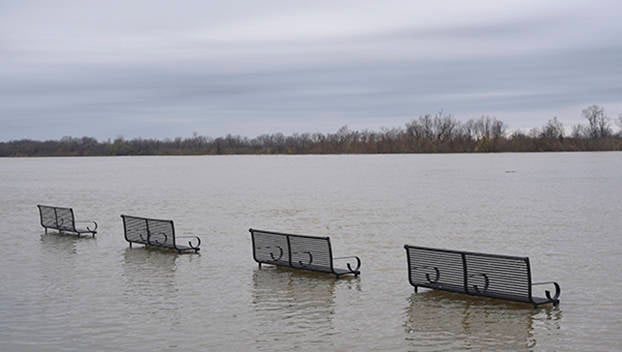Midwest floods and regional rains cause Mississippi River to swell (again)
Published 2:11 pm Thursday, May 9, 2019
The Army Corps of Engineers’ New Orleans office is asking to open a historic flood control structure above New Orleans for an unprecedented second time in one year.
The request comes as floods across the Midwest have caused billions of dollars of damage to homes, farms and other businesses.
Continued rains in the Midwest and Ohio Valley and floodwaters from the upper Mississippi River are heading down the Mississippi, National Weather Service hydrologist Jeffrey Graschel said Thursday. In addition, he noted, storms are expected to dump 5 to 10 inches (13 to 25 centimeters) of rain in parts of Louisiana and Arkansas.
Corps spokesman Matt Roe said the New Orleans office is asking the Corps’ Mississippi Valley Division for authority to reopen the Bonnet Carré spillway to relieve stress on New Orleans levees. The agency scheduled a news conference Thursday afternoon about the spillway and other flood-fighting efforts on the Mississippi and Atchafalaya rivers.
The spillway gets opened to relieve stress on New Orleans levees when the Mississippi flows at 1.25 million cubic feet (35,400 cubic meters) per second — fast enough to fill the Empire State Building in 30 seconds.
The spillway, completed in 1931, is a 1.5-mile-long (2.4-kilometer-long) construction of 350 concrete bays and 7,000 huge timbers called needles. Its unusually early opening in February marked the 13th time it has been used since then, but only the second use in consecutive years. At the earlier peak this year, 206 bays were opened, discharging 213,000 cubic feet (6032 cubic meters) of water per second into the spillway.
“This is the wettest year we’ve had in about 124 years in aggregate,” Maj. Gen. Richard Kaiser, the Mississippi Valley Division’s commanding general, said in April. He said it started last summer and continued all winter.
The water is diverted along a 6-mile (9.7-kilometer) course of guide levees to brackish Lake Pontchartrain, after which it flows to Mississippi Sound in the Gulf of Mexico.
Moby Solangi, director of the Institute for Marine Mammal Studies in Gulfport, Mississippi, said he’s concerned about the spillway opening, because it means that polluted fresh water will flow into the Sound, a nursery for dolphins and endangered Kemp’s ridley sea turtles.
There were more deaths in April among both species than in any April over the past five years, he said, with 28 dolphins and 57 sea turtles found dead. Solangi said many of the dolphins had lesions on their bodies from exposure to fresh water, which also damages oyster reefs and blue crabs, on which the turtles feed, and plants that are food for animals lower on the food chain.
He said 73 dolphins and 79 sea turtles have died so far this year. That compares, for example, to 82 dolphin deaths in all of 2016, the highest annual total in the past five years.
“We haven’t even started the year and it’s 73,” he said.
Graschel said the lower Mississippi hit its first peak in March and, though it went slowly down, never got down to normal. It’s unlikely to reach a seasonal norm until sometime in July if there isn’t any additional significant rain in the Missouri and Ohio river areas, he said.






